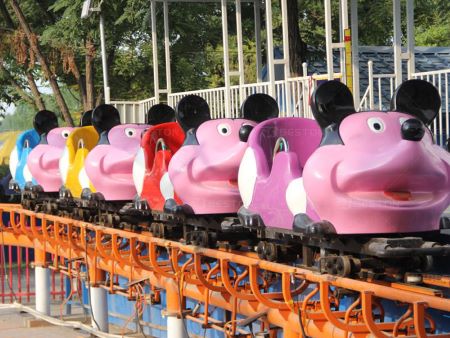


The Crazy Mouse has thrilling spins, while the Worm Coaster offers a gentle, family-friendly ride.
Roller coasters are the highlights of amusement parks, providing thrilling experiences. The Crazy Mouse Roller Coaster and the Worm Coaster cater to different audiences, differing in design, ride dynamics, target audience, and operational considerations. Understanding these differences is vital for amusement park owners contemplating ride investments.
The Crazy Mouse Roller Coaster features a compact track with sharp turns, sudden drops, and a unique spinning mechanism. The cars resemble oversized mice and rotate as they navigate the track, creating a sensation of losing control. This design is space-efficient, ideal for parks with limited room.
Conversely, the worm coaster offers a simpler design for younger riders and families. Its layout consists of gentle curves and small dips, simulating a worm’s motion. Positioned lower to the ground, it provides a calmer experience, with brightly colored cars resembling worms or caterpillars.
The Crazy Mouse Roller Coaster is known for its unpredictability. The cars spin at varying speeds based on rider weight distribution, adding excitement. This chaotic combination of rapid turns, steep drops, and spinning appeals to thrill-seekers, making it perfect for teenagers and adults.
In contrast, the worm coaster delivers a controlled experience. Its smooth movements introduce younger riders to roller coasters without overwhelming them. The gentle curves and mild slopes create a relaxing journey, making it suitable for families.
The Crazy Mouse Roller Coaster is designed for thrill-seekers who enjoy fast-paced attractions. Its unpredictable excitement keeps riders returning. Its compact design allows it to fit into smaller parks, making it versatile for operators.
The worm coaster targets younger children and families. Its gentleness is less intimidating for first-time riders, providing a safe experience. The colorful ride cars and low intensity make it a favorite among families, essential for family-oriented amusement parks.
The maintenance and operational costs differ significantly. The Crazy Mouse, with its spinning cars and complex track, requires frequent maintenance to ensure safety, leading to higher costs.
In contrast, the worm coaster’s simpler design incurs lower maintenance expenses. With fewer moving parts, it experiences fewer mechanical failures, leading to less frequent maintenance. For parks aiming to minimize costs while offering family-friendly attractions, the worm coaster is a cost-effective choice.
Both the Crazy Mouse Roller Coaster and the worm coaster allow for customization to align with park aesthetics. The Crazy Mouse often features themed cars and environments, enhancing the ride experience.
Similarly, the worm coaster can be themed to suit various settings, like enchanted forests or vibrant playgrounds. Its design fits well into whimsical environments, ideal for parks focused on younger audiences.
The Crazy Mouse Roller Coaster is a staple in amusement parks, known for its thrilling nature and compact design. Its ability to deliver high-intensity experiences makes it a favorite among park operators and visitors alike.
Conversely, the worm coaster remains popular among family-oriented parks. Its gentle dynamics ensure a steady market presence, as demand for family entertainment continues to grow.
In conclusion, the Crazy Mouse Roller Coaster and the worm coaster provide distinct experiences for different audiences. The Crazy Mouse offers high-thrill adventures, while the worm coaster delivers a gentle, family-friendly ride. Each ride serves its purpose, and the choice depends on the park’s target demographic and operational goals. Both rides contribute uniquely to the amusement experience.
